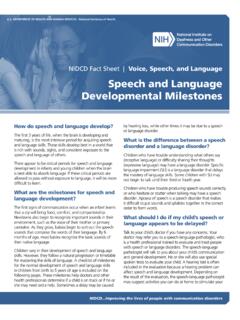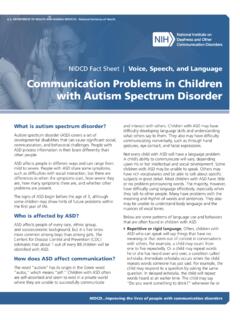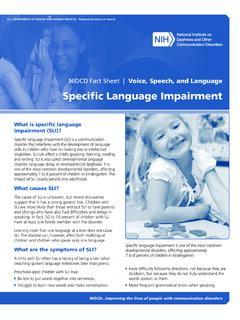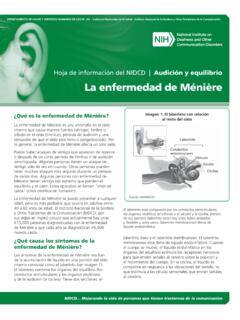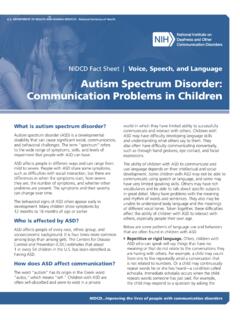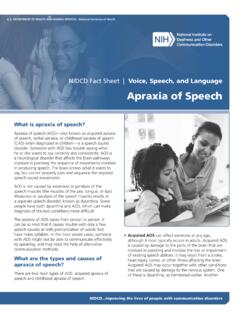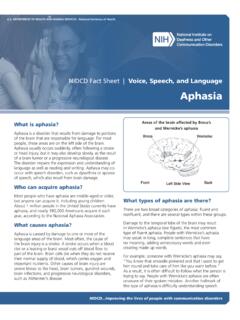Transcription of Presbycusis - NIDCD
1 (over)PresbycusisWhat is Presbycusis ? Presbycusis is the loss of hearing that gradually occurs in most individualsas they grow older. hearing loss is a common disorder associated withaging. About 30-35 percent of adults age 65 and older have a hearing is estimated that 40-50 percent of people 75 and older have a hearing loss associated with Presbycusis is usually greater for high-pitchedsounds. For example, it may be difficult for someone to hear the nearbychirping of a bird or the ringing of a telephone. However, the same personmay be able to hear clearly the low-pitched sound of a truck rumblingdown the are many causes of Presbycusis .
2 Most commonly it arises fromchanges in the inner ear of a person as he or she ages, but Presbycusis canalso result from changes in the middle ear or from complex changes alongthe nerve pathways leading to the brain. Presbycusis most often occurs inboth ears, affecting them equally. Because the process of loss is gradual,people who have Presbycusis may not realize that their hearing is are the symptoms of Presbycusis ?With Presbycusis , sounds often seem less clear and lower in volume. This contributes to difficultyhearing and understanding speech.
3 Individuals with Presbycusis may experience several of the following: The speech of others seems mumbledor slurred. High-pitched sounds such as s and th are difficult to hear and tell apart. Conversations are difficult to understand,especially when there is background noise. A man s voice is easier to hear than thehigher pitches of a woman s voice. Certain sounds seem annoyingor overly loud. Tinnitus (a ringing, roaring, or hissing sound inone or both ears) may also theprocess of loss isgradual, peoplewho havepresbycusis maynot realize thattheir hearing are the causes of Presbycusis ?
4 Sensorineural hearing loss is caused by disorders of the inner ear or auditory nerve. Presbycusis is usuallya sensorineural hearing disorder. It is most commonly caused by gradual changes in the inner ear. Thecumulative effects of repeated exposure to daily traffic sounds or construction work, noisy offices, equip-ment that produces noise, and loud music can cause sensorineural hearing loss. Sensorineural hearingloss is most often due to a loss of hair cells (sensory receptors in the inner ear). This can occur as a resultof hereditary factors as well as aging, various health conditions, and side effects of some medicines(aspirin and certain antibiotics).
5 Presbycusis may be caused by changes in the blood supply to the ear because of heart disease, high bloodpressure, vascular (pertaining to blood vessels) conditions caused by diabetes, or other circulatory prob-lems. The loss may be mild, moderate, or Presbycusis is a conductive hearing disorder, meaning the loss of sound sensitivity is caused byabnormalities of the outer ear and/or middle ear. Such abnormalities may include reduced function of thetympanic membrane (the eardrum) or reduced function of the three tiny bones in the middle ear thatcarry sound waves from the tympanic membraine to the inner can be done?
6 Much of the hearing loss caused by noise exposure can be prevented. Awareness of potential sources ofdamaging noises, such as firearms, snowmobiles, lawn mowers, leaf blowers, woodworking machinery andloud appliances is important. Ear plugs or special fluid-filled ear muffs can give protection and should beworn to help avoid the possibility of damage to hearing . Excessively loud everyday noises, both at homeand at work, can pose a risk to a person s hearing . Avoiding loud noises and reducing the amount of timeone is exposed to everyday noises may be are many strategies to help people with Presbycusis .
7 hearing aids may be recommended for someindividuals. Assistive listening devices can provide further improvement in hearing ability in certainsituations. One example of such a device is the built-in telephone amplifier. Another example is FMsystems that make sounds clearer, with or without a hearing aid, by delivering sound waves like a in speechreading (using visual cues to determine what is being spoken) can help those withpresbycusis to understand better what is being said in conversations or is a hearing aid selected?
8 Consultation with specially trained professionals who work as a team is important for evaluation of ahearing loss and selection of appropriate management. An otolaryngologist (ear, nose and throat special-ist) should evaluate the individual with a hearing problem to make the diagnosis and exclude relatedsystemic disorders that may contribute to the problem. An audiologist is a professional who measures thehearing and identifies the type of hearing loss. The audiologist conducts a complete hearing evaluationand determines if a hearing aid may be useful.
9 The individual is counseled about how a hearing aid mayimprove listening situations. Then the audiologist conducts tests to find an appropriate aid, selecting onethat maximizes a person s hearing and understanding of speech. Most older adults with hearing loss canbenefit from using a hearing aid, although the degree of benefit may vary according to the type andamount of hearing tipsIf you have a hearing loss caused by Presbycusis or know someone who does, share these tips with familymembers, friends, and colleagues.
10 Face the person who has a hearing loss so that he or she can see your face when you speak. Be sure that lighting is in front of you when you speak. This allows a person with a hearing impairmentto observe facial expressions, gestures, and lip and body movements that provide communication clues. During conversations, turn off the radio or television. Avoid speaking while chewing food or covering your mouth with your hands. Speak slightly louder than normal, but don t shout. Shouting may distort your speech. Speak at your normal rate, and do not exaggerate sounds.

